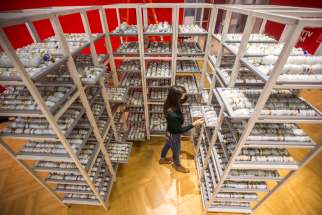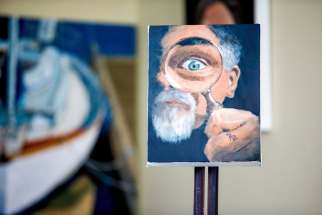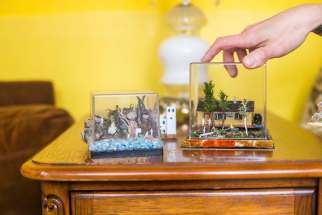More than memories Exhibition features art that honours victims of historical violence while inspiring future action
Read this article for free:
or
Already have an account? Log in here »
To continue reading, please subscribe:
Monthly Digital Subscription
$0 for the first 4 weeks*
- Enjoy unlimited reading on winnipegfreepress.com
- Read the E-Edition, our digital replica newspaper
- Access News Break, our award-winning app
- Play interactive puzzles
*No charge for 4 weeks then price increases to the regular rate of $19.00 plus GST every four weeks. Offer available to new and qualified returning subscribers only. Cancel any time.
Monthly Digital Subscription
$4.75/week*
- Enjoy unlimited reading on winnipegfreepress.com
- Read the E-Edition, our digital replica newspaper
- Access News Break, our award-winning app
- Play interactive puzzles
*Billed as $19 plus GST every four weeks. Cancel any time.
To continue reading, please subscribe:
Add Free Press access to your Brandon Sun subscription for only an additional
$1 for the first 4 weeks*
*Your next subscription payment will increase by $1.00 and you will be charged $16.99 plus GST for four weeks. After four weeks, your payment will increase to $23.99 plus GST every four weeks.
Read unlimited articles for free today:
or
Already have an account? Log in here »
Hey there, time traveller!
This article was published 23/04/2021 (1696 days ago), so information in it may no longer be current.
At first blush, they look like regular coffee cups, stowed in neat stacks. There are thousands of them, and they are all different — some have roses climbing the sides, others are stark white — evoking kitchens and café tables, and the intimate conversations, connections and rituals those spaces allow.
For well over a decade, Bosnian-American artist Aida Sehovic has been collecting fildzani, the little porcelain cups traditionally used for coffee service in Bosnia and Herzegovina.
Exhibition Preview
Artivism
● Canadian Museum for Human Rights
● April 30-Jan. 16, 2022
Her goal: a cup for every one of the 8,372 Bosnian Muslim men and boys who were killed in the genocide in Srebrenica in July 1995.
Sehović’s installation, STO TE NEMA (“Why are you not here?”), is part of Artivism, an exhibition opening at the Canadian Museum of Human Rights that highlights the work of six different artists and art collectives, from six different regions in the world, whose artworks are both a response to identity-based mass atrocity as well as a tool of activism to prevent it.
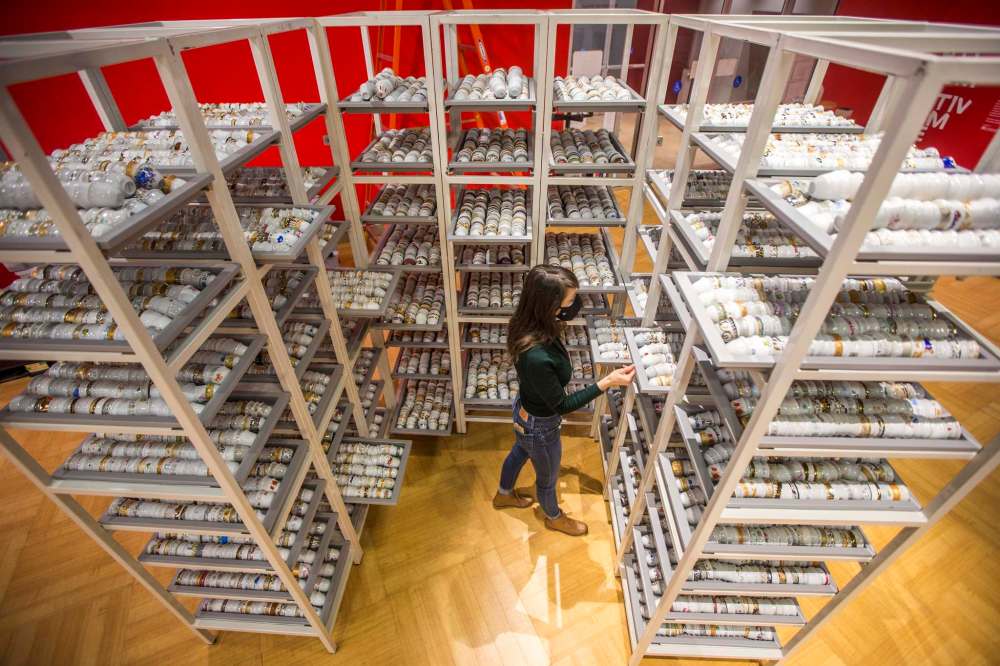
The exhibition, which made its première at the 2019 Venice Biennale, was developed by the Auschwitz Institute for the Prevention of Genocide and Mass Atrocities. Artivism makes its Canadian debut at the CMHR on April 30 and will be on view until Jan. 16, 2022. This version was adapted by the CMHR in collaboration with the Auschwitz Institute.
Kerry Whigham is the director of research and online education at the New York City-based Auschwitz Institute. He first curated Artivism, along with Francesca Giubilei and Luca Berta.
Blanket a witness to history
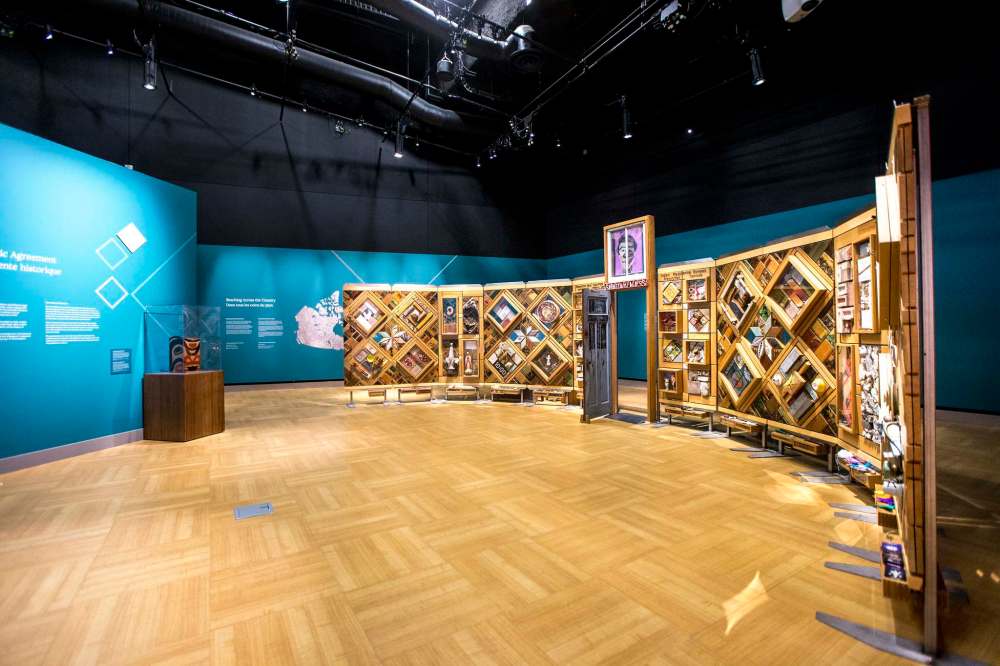
Posted:
In many cultures, blankets are a symbol of comfort and protection. We wrap our babies in blankets; we wrap our dead in blankets, too. In Indigenous cultures, blankets hold powerful significance, used in ceremony and storytelling.
The idea originated in 2017, when Whigham and his team began discussing what would it look like to have a pavilion at the Venice Biennale that focused on the connections between art, human rights and genocide prevention. Whigham is also an academic, studying and working with artists around the world “who have developed these really creative ways of responding to that history of violence in each given country,” he says over the phone from his home office in New York. “So that’s where I had the idea that we could focus on highlighting the really exceptional creative work of artists in different countries around the world to show how art has been used as a form of activism to respond to these histories of violence and transform societies in the present.”
The works that compose Artivism are striking examples of the transformative power of art, each work giving voice and humanity to those who have had theirs taken away through force and violence. In addition to Sehović’s installation, there’s Argentina’s Grupo de Arte Callejero (GAC), whose street signs were posted all over Buenos Aires in the 1990s, highlighting human rights abuses committed during the 1976 coup d’etat and ensuing military dictatorship, and pointing out where perpetrators were living with impunity.
Indonesian-born, Belgium-based artist Elisabeth Ida Mulyani’s Oleh-oleh (Souvenir) is a sculptural and sound installation of 13 golden ears, each one representing an activist punished for speaking out against the dictatorial regime that began in a period of violence in 1965; the black umbrellas suspended above represent the mothers of these activists, who protested in front of the presidential palace in Jakarta each Thursday.
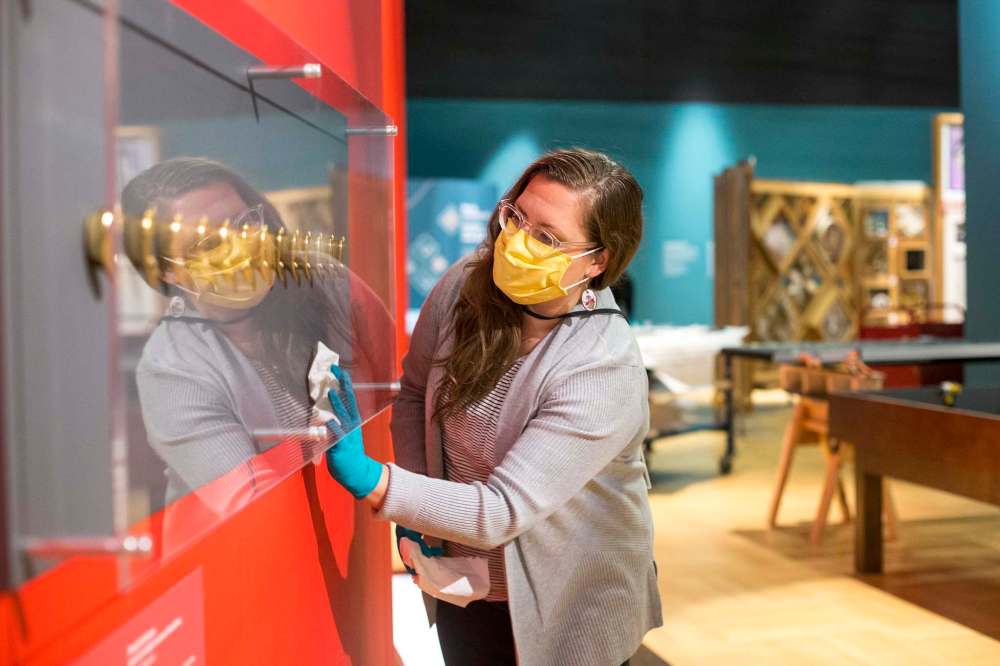
Supervivere, meanwhile, is a photo series featuring Indonesian exiles whose citizenship was revoked in 1965.
For Masks of Yazidi Women, Iraqi-Kurdish artist Rebin Chalak created casts of the faces of women and girls who were captured, kept in cages and forced into sexual slavery by the Islamic State of Iraq and the Levant during its genocidal campaign against the Yazidi religious minority in northern Iraq. The masks displayed in Artivism are from survivors who escaped.
The Intuthuko Embroidery Project was created by a group of South African women who turned to stitchery to tell their stories of life during and after apartheid, as well as to build community.
For nearly a century, residential schools operated across Canada, systematically robbing generations of Indigenous children of their identities, languages, cultures, and families. The art that tells the story of that system comes from the the National Centre for Truth and Reconciliation. Art and objects were donated to the Truth and Reconciliation Commission of Canada by school survivors as part of their testimonies.
Linda Young, 70, is a Plains Cree artist who lives in Saskatoon. A residential school survivor, her works appear in Artivism.
Young’s great-grandmother gathered medicines, and Young has memories of seeing those bags of tradition, healing and care around her home. Young herself had medicine bags she’d been collecting, and she thought about her great-grandmother when it came time to tell her story of her decade in residential school. “I decided to take my story and preserve it in a way that looked after it and protected it and honoured it,” she says via Zoom.
Her story is now held by medicine bag squares, each one secured with prayer ties. “And I did that until the story was done,” she says. More than 200 pouches make up the long strings that form a swing or a cradle when hung up. A poem, printed on a quilt made from onion skin and red wax seals, speaks to intergenerational trauma.

In 2012, when the commission came to Saskatoon, Young was invited to place her story into a sacred bentwood box. She didn’t think her story, as she’d preserved it, would fit.
“It was really amazing because when they put it in there, it’s almost like this block just expanded to accept whatever you put in it,” she says. “It was such a magical feeling. I was so impressed. Like, I just I never forgot that experience of the story being accepted no matter what it was, or the size of it.”
Jeremy Maron, a researcher-curator at the CMHR, says Artivism offers an accessible and emotional entry point for viewers to learn about not only the atrocities themselves but also the work of these artists to, as Maron says, “make sure these atrocities are not forgotten, they’re not covered up, the victims’ agency and their dignity is respected.”
At the CMHR, Artivism has more space to stretch out than it did in Venice. The pandemic also changed certain elements of the installation, for which the artists had to give directions via video chat. The hand crank used to view the South African embroidery, for example, needed to be replaced with a motion-activated conveyor belt.
Narrowing the exhibition down to six wasn’t an easy task for the original curatorial team– to that end, there is the potential for an Artivism 2 or Artivism 3.
Narrowing the exhibition down to six wasn’t an easy task for the original curatorial team — to that end, there is the potential for an Artivism 2 or Artivism 3 — but Whigham wanted to shed light on atrocities that perhaps haven’t received as much attention. He says that Canada’s residential school system, for example, was a “big point of discovery” for the audience in Venice. “They just had no idea about this history in Canada.” (Many Canadians also had no idea about this history in Canada.)
It’s a big exhibition tackling big issues, but it’s the smaller details of the artworks — the coffee cups, the ears, the umbrellas, the masks, even the tiny embroidery stitches — that help bring these atrocities back down to the individual level, and remind the viewer of the actual people who make up the staggering statistics. These intimate stories cannot be told in numbers alone.
“Those numbers are so large, that it’s hard to understand that actually what that represents is not just six million people, but one person, after another person, after another person — six million individuals,” Whigham says, referring to the number of Jewish people systemically murdered by the Nazis during the Holocaust as an example. “That’s why, if we understand these things not as just this big, mass violence that takes control of an entire society, but as one person’s rights being denied, then another person, then another person, that helps us to see where we can intervene and where our intervention matters.”
One of the goals of Artivism is to get people thinking about what they, as individuals, can do.
“When people hear the term ‘genocide prevention,’ they think of governments and their responsibility, oftentimes to intervene with the military in the midst of mass crisis or mass killing that’s happening somewhere else in the world — and we really try to push against that,” Whigham says.
“So there are things that we all can do to respond to identity-based violence that’s happening in our own communities to make sure that the groups who are most at risk because of their identity are protected.” – Kerry Whigham, Auschwitz Institute director of research and online education
“We think of atrocity prevention as a much more long-term process that involves all actors at every level of society. So there are things that we all can do to respond to identity-based violence that’s happening in our own communities to make sure that the groups who are most at risk because of their identity are protected, that their rights are respected. Ultimately, for the rights of people to be protected, it requires all of us working together.”
That’s why Artivism will invite visitors to participate in the 60/60/60 Challenge, which was created in collaboration with the National Center for Civil and Human Rights in Atlanta, Ga. Visitors will identify a human rights issue that they feel passionate about, and then commit to taking action for 60 seconds, 60 minutes, or 60 days.
“The emphasis of the exhibit is on response and action,” Maron says. “We wanted to make sure — and the Auschwitz Institute wanted to make sure — that visitors have an opportunity to reflect on steps that they can take. Even if they’re small, small steps are still more important than no steps.”
jen.zoratti@freepress.mb.ca
Twitter: @JenZoratti

Jen Zoratti is a Winnipeg Free Press columnist and author of the newsletter, NEXT, a weekly look towards a post-pandemic future.
Our newsroom depends on a growing audience of readers to power our journalism. If you are not a paid reader, please consider becoming a subscriber.
Our newsroom depends on its audience of readers to power our journalism. Thank you for your support.





